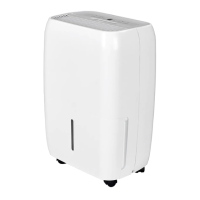8
ENGLISH
d) Pump down refrigerant system, if possible.
e) If avacuum is not possible, make amanifold so that refrigerant can be removed from various
parts of thesystem.
f) Make sure that cylinder is situated on thescales before recovery takes place.
g) Start therecovery machine and operate in accordance with manufacturer’s instructions.
h) Do not overfill cylinders. (No more than 80 % volume liquid charge).
i) Do not exceed themaximum working pressure of thecylinder, even temporarily.
j) When thecylinders have been filled correctly and theprocess completed, make sure that
thecylinders and theequipment are removed from site promptly and all isolation valves on
theequipment are closed off.
k) Recovered refrigerant shall not be charged into another refrigeration system unless it has
been cleaned and checked.
18. Labelling
Equipment shall be labelled stating that it has been de-commissioned and emptied of refrigerant.
Thelabel shall be dated and signed. Ensure that there are labels on theequipment stating
theequipment contains flammable refrigerant.
19. Recovery
When removing refrigerant from asystem, either for servicing or decommissioning, it is
recommended good practice that all refrigerants are removed safely.
• When transferring refrigerant into cylinders, ensure that only appropriate refrigerant recovery
cylinders are employed. Ensure that thecorrect number of cylinders for holding thetotal
system charge are available. All cylinders to be used are designated for therecovered
refrigerant and labelled for that refrigerant (i.e. special cylinders for therecovery of refrigerant).
Cylinders shall be complete with pressure relief valve and associated shut-off valves in good
working order.
• Empty recovery cylinders are evacuated and, if possible, cooled before recovery occurs.
• Therecovery equipment shall be in good working order with aset of instructions concerning
theequipment that is at hand and shall be suitable for therecovery of flammable refrigerants.
In addition, aset of calibrated weighing scales shall be available and in good working order.
• Hoses shall be complete with leak-free disconnect couplings and in good condition. Before
using therecovery machine, check that it is in satisfactory working order, has been properly
maintained and that any associated electrical components are sealed to prevent ignition in
theevent of arefrigerant release. Consult manufacturer if in doubt.
• Therecovered refrigerant shall be returned to therefrigerant supplier in thecorrect recovery
cylinder, and therelevant Waste Transfer Note arranged. Do not mix refrigerants in recovery
units and especially not in cylinders.
• If compressors or compressor oils are to be removed, ensure that they have been evacuated
to anacceptable level to make certain that flammable refrigerant does not remain within
thelubricant. Theevacuation process shall be carried out prior to returning thecompressor
to thesuppliers. Only electric heating to thecompressor body shall be employed to
accelerate this process. When oil is drained from asystem, it shall be carried out safely.

